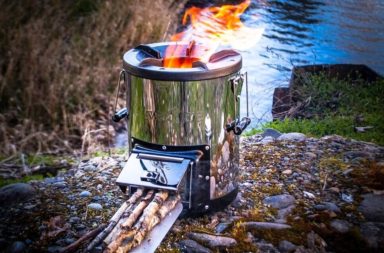When one thinks of off grid toilets, the classic backyard privy or outhouse comes to mind. Technology for off grid sanitation has come a long way from just digging a pit, and with the advent of various types of manufactured or homemade composting toilets becoming readily available, a homesteader has a lot of options to choose from and consider.
However, there is always a chance that a grid down event like a natural disaster will cause you to revert to very basic sanitation measures so understanding emergency toilets is an important disaster preparedness consideration. Now the simplest and easiest method that I can offer you is nothing more than taking an empty garbage bag and lining your toilet bowl with it.
How To Modify A Conventional Commode Into An Off Grid Toilet
- Turn the water valve to the toilet off.
- Flush out any water still in the bowl – the toilet shouldn’t refill
- Line your toilet bowl (under the seat) with a plastic kitchen garbage bag inside another kitchen garbage bag.
- Put some kitty litter, peat moss, lime, or something similar that will absorb liquid and help reduce odors into the inner bag. You can use dry leaves or pine straw, Spanish moss etc. also, but let me add an insightful warning here. You really don’t want to do that substitution, if you can help it. Down here in the deep South with have what we call red bugs, they are called chiggers up North, and those microscopic red spidery looking things can hide in that type of material quite easily as well as ticks and other creatures: you don’t need surprises from while sitting on the throne! I suppose you could steam that kind of organic material in a colander over a pot on a fire and then let it dry thoroughly overnight but that burns fuel and calories and would be tedious.
- Go to the bathroom in the inner bag. You may be able to use the same bag more than once before replacing. Once the inner bag is full or you feel it needs to be replaced, tie it up. Insert a new inner bag and add absorbent/odor reducer for the next use.
- Store the used bags away from kids, pets, and wildlife. For example, place the bags in the garage and inside the garbage can for disposal. For long term disasters you bury it.
One suggestion I have for you to consider is if you are the type of prepper that has the space for an extra 5-gallon bucket or has bought one of those premade 5-gallon buckets with a toilet seat is going by a local cabinet shop or wood mill and filling it with sawdust for free. This material is good for absorbing liquids as is and there is a commercial made product called Poo-Pourri that you can spritz on it that should help reduce odors even better.
People in Asia and other countries have used human manure for centuries to increase crop yields. I am not advocating or suggesting that in any way but a simple compost toilet basically consists of a bucket which you do your business into. I advise you for your toiletry comfort, to put a specially-fitted toilet seat on top of the bucket. Failing that you can take the seat off your existing toilet but it will slide around. Let me paint you a mental picture of what else you can do.
If you take two tree limbs (large enough branches or limbs to support your weight) and lash them between two trees (one limb in front of each other with the tree trunks supporting in middle) This will form you a platform to place your commercial toilet seat on. Instead of digging a slit trench under it for a latrine you can put your bucket under that.
After each use, you put a bit of sawdust into the bucket. When the bucket is full, you put the toilet seat on a new, clean bucket. The bucket full of sawdust and waste goes in a composting heap. Sprinkle some more sawdust over the waste so it stays covered while composting further.
Because pee is sterile (with the exception of some cases such as if you have a kidney infection), a lot of people prefer to use separate buckets for pee and poo. The pee can be safely dumped in your yard. I have instructions in my book Bug Out Gardening that advises you how to use urine as fertilizer. Getting back to the two bucket potty, without having pee in the poo bucket, the poo will dry out a lot faster.
Build Your Own disaster Toilet
Take a regular plastic 5-gallon bucket to use as a toilet and line it with a heavy-duty garbage bag, doubling it if possible. Keep the bucket tightly covered and clean to reduce flies and reduce smells.
As an added precaution or prep, even non-cat owners should have cat litter available. Try adding about 1 cup of litter to the plastic garbage bag daily to help absorb some of the liquid. The bag itself needs to be changed daily if you can. Stocking up on extra trash bags specific for your disaster toilet use is wise. If possible, dig a hole and bury soiled bags at least 10 inches deep to ensure rodents and pets can’t get at it. Make sure it is securely closed and at least 100 feet away from any drinking water source. Now if it is only a short-term disaster you can use your garbage can to dispose of waste.
If the emergency DIY measures above are not a possibility and you don’t have access to a toilet, a “cat hole” can be an option. Cat holes, or personal use holes, are holes you dig in the ground and squat over. Each hole is one-time use.
- Dig the hole on dry land at least 100 feet away from wells, homes, and open waterways – streams, rivers, lakes. Avoid sloped areas that could erode your cat hole in the rain.
- Each hole should be dug at least 6-inches deep and about 6-inches in diameter. Toilet paper can be disposed of in the hole. Wet-wipes, tampons, and other materials that are less biodegradable should be put into a plastic bag and thrown in the garbage. After you’re done going to the bathroom, cover the hole and pack the dirt down to avoid attracting pets or other animals.
- Mark or remember where you dug your hole to avoid accidently digging up a used hole.
When you decide to live off grid as a lifestyle, keep in mind you are also disconnecting yourself from the municipal sewage system. This expense is often not calculated or considered well enough, so look at options and costs and do your research. Land use permits for septic tanks, percolation tests, building permits for plumbing adaptations etc. will vary from city to county so explore in depth what your local authorities might require. You will want to observe all applicable state laws or risk fines.
Self-contained Composting Toilets
Self-contained composting toilets are installed directly in the bathroom. They are available in both electric and non-electric versions. These toilets look like traditional flush toilets but instead of flushing the waste away, it collects it and helps to accelerate the breakdown of the waste into fertilizer.
Waterless Incinerating Toilet

Photo courtesy of Biolet
Plan a location for the toilet that takes into account the chimney system needed for the toilet to function properly. A waterless incinerating toilet burns waste within the unit. A system within the toilet moves the waste to a special chamber for incineration after the toilet has been used.
Place the waterless incinerating toilet on the floor of the restroom. The units are self-contained and require no plumbing, sewer or septic pipes.
Waterless Composting Toilet

Place the toilet in a location that will allow you to place a pipe from the base of the toilet through the floor to the basement, outside or another place where the composting unit can be installed
Connect the 12-inch wide stainless-steel connecting chute to the bottom of the toilet. Install the compost chamber in a basement or another room directly below the location of the toilet. If you do not have a basement, you can route the pipe outside. Connect the chute to the chamber.
Hook up the air-compression system next to the compost chamber. This system will be included in the toilet kit and will provide the suction for the forced-ventilation system. Install the vent stack that will go outside from the compost chamber. Oxygen will be pulled down the toilet’s chute into the chamber and out through the vent stack. The waste will be composted and made into a useful mixture for fertilizer. The removal must only occur every 10 to 15 years depending on usage.
Prices of composting toilets can run the gamut of anywhere from $500 to $10,000 depending on your needs, household size and desired end use of the product produced.
Composting toilets are not practical in some situations, like apartments and cold climates with little activity. Choosing a composting toilet with the right waste processing capacity and options for your intended use can be tricky business, so if you’re at all unsure about your needs you need to consult a professional.
Most people would agree you can’t have too much food stored for an emergency but the same holds true for toilet paper. In these modern times it’s hard to imagine a nation-wide toilet paper shortage but it could happen easily enough. Have you given any thought to what you will do when you run short of TP? You can resort to plants or pages out of a book etc. but you are going to be very uncomfortable!
Our prisoners that were taken by the Japanese in World War II often times had it even worse and there are stories of each soldier had a little piece of rag they would try to wash out with urine after each use.
You might want to consider storing cloths you could wash and sanitize should the unthinkable ever happen and you find yourself with no toilet paper. Store plenty of personal hygiene and sanitation supplies, it just makes good sense and there are no shelf life worries or thoughts these type of things will ever go to waste, or is there?
Feature image courtesy of Pixabay


